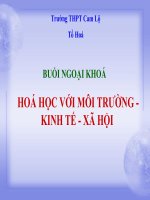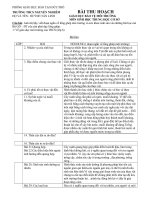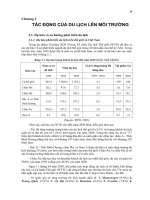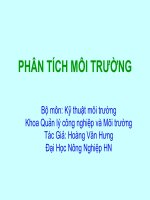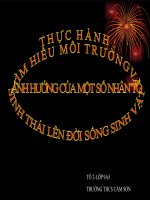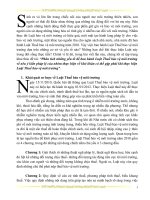Giáo trình anh văn chuyên ngành môi trường 2
Bạn đang xem bản rút gọn của tài liệu. Xem và tải ngay bản đầy đủ của tài liệu tại đây (22.41 KB, 2 trang )
English Course for Students of Faculty of Biology
Page 1 of 2
PART 2 LISTENING AND READING COMPREHENSION
Unit 1
CAMOUFLAGE
Read and listen to the following part of the lecture about camouflage
Most animals in the world have some kind of way to hide themselves so that they can hunt for food and
protect themselves from other animals. This method of hiding is called camouflage. The simplest form of
camouflage is for animals to "blend in" with their surroundings. Their colors match the surroundings in
which they live, which makes them hard to see. Deer and other forest animals, for example, have light
brown colors that help them blend in with the brown trees and dirt on the forest ground. Many fish have a
gray-blue color. This helps them blend in with the soft light under water. Other animals use color patterns
to help them blend in. A tiger's pattern of black stripes and orange fur blends into the long grass where it
hunts. This makes the tiger difficult for its victims to spot—until it's too late!
Another form of camouflage is called copying. For instance, a king snake is red, yellow, and black. It
copies the colors of the coral snake. The coral snake is very dangerous; its bite can kill you. The king
snake is not dangerous, but other animals are afraid to attack the king snake because it looks like a coral
snake. A third form of camouflage is disguise. This means that an animal looks like something else. For
instance, a crocodile in the water can look just like a floating log. This disguise helps it catch deer when
they come near the water to drink.
A. Vocabulary and structure
Task 1: Match each word in A with its definition or synonym in B together
A B
1. hide a) For example
2. Blend b) To try to hurt or defeat using violence
3. Spot c) Camouflage
4. Stripe d) piece cut from tree
5. Fur e) Look similar to
6. Victim f) To see or notice (someone or something)
7. For instance g) Band of colour
8. Attack h) Soft dense coat of hair on a hairy animal
9. Log i) someone or something which has been hurt, damaged or killed
10. Disguise j) Move out of sight
Task 2: Complete the sentences using the appropriate words in task 1
1. In the coal industry, ………… , 5000 jobs are being lost.
2. Most wild animals won't …………… humans unless they are provoked.
3. Persian cats have long ……………
4. Some butterflies ……………. in with their surroundings so that it's difficult to see them.
5. She claimed that as a child she had been the ………… of sexual abuse.
Task 3: Choose the best complete among A, B, C and D for the following sentences
1. I don't eat meat, but I like ………. types of fish.
A. most B. almost C. every D. each
English Course for Students of Faculty of Biology
Page 2 of 2
2. Will this type of sun block ………. me from ultraviolet light?
A. stop B. prevent C. hide D. protect
3. If two colours or designs ……… , they are similar and look good together.
A. suitable B. match C. adequate D. the same
4. He likes travelling abroad and learning about ………. people's customs and traditions.
A. different B. else C. other D. another
5. The chameleon survives by ……… in with its background.
A. changing B. turning C. blending D. putting
6. The new methods of ……… English encourage students to speak more in class.
A. teach B. teaching C. to teach D. taught
7. I prefer clothes which are made out of natural materials ……… cotton and wool.
A. like B. alike C. for example D. for instance
8. These are principles in ……. we all believe.
A. which B. that C. who D. whom
9. Being good at English ………. it easier for you to find a good job.
A. does B. has C. causes D. makes
10. There are some ……… logs along the river.
A. float B. floated C. floating D. to float
B. Reading comprehension:
Choose the best answer for each question from 1 to 3
1. How does the professor organize the information in the lecture?
(A) Most common to least common
(B) Type followed by example
(C) Most effective to least effective
(D) Small animals to large animals
2. What are the three main types of camouflage mentioned in the talk?
(A) Blend in, copy, surprise
(B) Run away, blend in, hide
(C) Copy, disguise, blend in
(D) Disguise, change colors, copy
3. Which animals use camouflage to blend in with their surroundings?
(A) Deer and tigers
(B) Fish and snakes
(C) Tigers and crocodiles
(D) Snakes and birds

